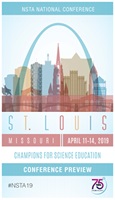Jazzing Up Science with Cross-Curricular Connections: Featured Strand at NSTA’s 2019 National Conference on Science Education in St. Louis, MO, April 11–14
By Carole Hayward
Posted on 2019-01-27
It’s too time-consuming… We haven’t been properly trained… Assessment is too difficult… Subject integrity may be relaxed… There are many reasons teachers find it challenging to make cross-curricular connections. But the benefits far outweigh them—curricula can be more relevant, more diverse voices can be shared, learning time and space can be more flexible, and so many more.
For science teachers who enjoy this type of collaboration (or want to be able to enjoy it), we’re pleased to invite you to take a closer look at a special strand “Jazzing Up Science with Cross-Curricular Connections” being featured at our 2019 National Conference on Science Education, in St. Louis, April 11–14. Our conference organizers know that Integration within the sciences or among other disciplines leads to deeper learning and understanding for all students. This strand will focus on ways that science and other subject areas can be integrated, including the best way to bundle disciplinary core ideas. This strand will be targeted by level: novice, intermediate, or advanced attendees.
Sessions organized around this strand include a featured presentation on Saturday, April 13, 2:00 to 3:00 PM (“Hulahula and Learn Something…Expressing Science Through Culture and Dance”) by Kiana Frank, Assistant Professor, Pacific Biosciences Research Center. Weaving stories from traditional and contemporary scientific observations to explain the world around her—from micro to macro scales—Frank hopes to advance our understanding of how we fit into and influence our place. The expression of these stories through movement, as was done traditionally in Hawaii through the art of hula (dance), enables the expression of emotion and spirituality that is vital to perpetuating indigenous science and increasing comprehension, engagement, and enthusiasm of science in our students and communities. Expressing science in a cultural context through dance, not only better connects us to a concept or a place, but also engages the imagination by developing connections to that which we cannot see—the multiple layers of meaning and levels of knowledge that cross disciplines to achieve deeper learning.
And there will be hundreds more sessions in St. Louis that explore the use of phenomena in the science classroom; below is a small sampling:
- Crosscutting Concepts and Using Your Science “Eye”
- Physics Is a Story: Weaving History and Diversity into Physics Education
- Do It, Talk It, Write It: Incorporating Literacy and Digital Media to Promote Meaning Making for Young Learners
- Not Enough Time? Fill Your Day with Nature!
- Serving Up Science Through Independent Learning Menus
- The Flight of the Bumblebee: A New Multimodal STEM Text Set and Related Activities for Diverse Middle School Learners
- Learn Physics, Not Equations
- SC-5: Blending the E and the S in STEM (ticket required)
- Providing Real-World Relevance to Students of All Abilities Using CDC Public Health Lessons
- Place-Based Projects Making a Difference on Your School Campus
- STEAM on the Street: Surprising Everyday STEAM Encounters!
- Maker Movement: Building Bridges Between Science and English Language Arts
- Busy Beavers: Engineering Excitement in the Classroom
- STEM All Day Long…and Still Cover the Standards!
- Integrating Science and Literacy Instruction with Struggling Readers
- Science Stated Clearly: Teaching Chemistry and Biology with Animation
- The Young Artist as Scientist: What Can Leonardo da Vinci Teach Us?
- Blocks and Beyond: The Importance of Spatial Understandings in STEM
- Engaging Early Learners Through Cross-Curricular Integrated STEM Experiences
- STEM and NGSS No Longer Separate, But Still Equal
- Learning from Nature: STEAM Investigations for the Elementary Classroom
 Some of the connections teachers make happen outside of the classroom. Attendees thinking of working across the curriculum, or even to expand their students’ horizons further, can join their peers on Saturday, April 13, for the Community Connections Share-a-Thon. The organizers invite you to come and engage with organizations that bring you exciting resources, programs, and opportunities available to you from museums, after-school, media, and other informal science education providers! At the share-a-thon, you’ll find:
Some of the connections teachers make happen outside of the classroom. Attendees thinking of working across the curriculum, or even to expand their students’ horizons further, can join their peers on Saturday, April 13, for the Community Connections Share-a-Thon. The organizers invite you to come and engage with organizations that bring you exciting resources, programs, and opportunities available to you from museums, after-school, media, and other informal science education providers! At the share-a-thon, you’ll find:
- Interactive hands-on activities
- New and engaging ways to connect with your students
- FREE programs and resources
Pro Tips
Check out more sessions and other events with the St. Louis Session Browser. Follow all our conference tweets using #NSTA19, and if you tweet, please feel free to tag us @NSTA so we see it!
Need help requesting funding or time off from your principal or supervisor? Download a letter of support and bring it with you.
And don’t forget, NSTA members save up to $90 off the price of registration. Not a member? Join here.
Future NSTA Conferences
2019 National Conference
St. Louis, April 11–14
2019 STEM Forum & Expo
San Francisco, July 24–26
The mission of NSTA is to promote excellence and innovation in science teaching and learning for all.
Follow NSTA
Disclaimer: The views expressed in this blog post are those of the author(s) and do not necessarily reflect the official position of the National Science Teaching Association (NSTA).


